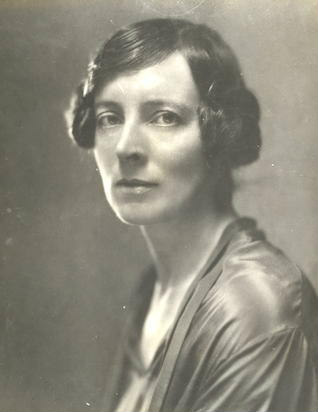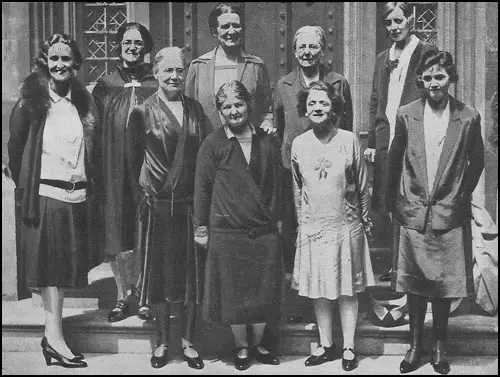Queer Places:
University of Cambridge, 4 Mill Ln, Cambridge CB2 1RZ
Golders Green Crematorium
Golders Green, London Borough of Barnet, Greater London, Englan
 Mary
Agnes "Molly" Hamilton (née Adamson, 8 July 1882 – 10 February 1966)[1]
was the first woman Journalist (The Economist) in 1913. A friend of
Margaret Bondfield, she wrote her
biography in 1924. Mary Agnes Hamilton was a close friend of
Elizabeth Robins,
Rose Macaulay,
Ellen Wilkinson and
Lady Astor.
Mary
Agnes "Molly" Hamilton (née Adamson, 8 July 1882 – 10 February 1966)[1]
was the first woman Journalist (The Economist) in 1913. A friend of
Margaret Bondfield, she wrote her
biography in 1924. Mary Agnes Hamilton was a close friend of
Elizabeth Robins,
Rose Macaulay,
Ellen Wilkinson and
Lady Astor.
Molly Hamilton
was
a writer, journalist, broadcaster, civil servant, and the Labour Member
of Parliament for Blackburn from
1929 to 1931. Women liaised with each other internationally through the
League of Nations, the Women’s Freedom League, the British Commonwealth League
and the Save the Children Fund. They also collaborated in expressing their
political ideas through writing for journals such as Time and Tide edited by
Margaret Haig, The Shield edited by
Alison
Neilans, the Woman’s Leader coedited by
Elizabeth
Macadam, and collaborated to write books such as Our Freedom and
its Results by Five Women, edited by
Ray Strachey and with contributions by
Eleanor Rathbone, Ray Strachey,
Erna Reiss, Alison Neilans and
Mary Agnes Hamilton.
Mary Agnes Adamson (known as Molly), was born in Withington, Manchester,
the eldest of six children of Scottish parents: Robert Adamson, a professor of
logic at Glasgow
University, and his wife Margaret Duncan, a Quaker who had been a
teacher of botany at Manchester High School for Girls before their marriage in
1881.[2] The
family moved back to Scotland in 1889.
She was educated at Aberdeen and Glasgow Girls' High Schools before
attending the University
of Kiel in 1901 for seven months to learn German. She went up to Newnham
College, Cambridge (where her mother had also been a student) in 1901 to
read Classics, then Economics as part of the History tripos, graduating in
1904 with first-class honours.

Nine victorious members of the Labour Party at the 1929 General Election: Left to right, Cynthia Mosley, Marion Phillips, Susan Lawrence, Edith Picton-Turberville, Margaret Bondfield, Ethel Bentham, Ellen Wilkinson, Mary Hamilton and Jennie Lee.
Mary Agnes Hamilton was a prolific writer. During the 1910s she supported
herself through journalism, translating works from French and German, and
publishing books on ancient history and American presidents for children. In
the 1920s, she wrote for journals including the Review
of Reviews and Time
and Tide. She moved in literary circles with Leonard and Virginia
Woolf and the Strachey family; provided research assistance to Lawrence and Barbara
Hammond in Hertfordshire; and met regularly with intellectuals and
economists while living near Fleet
Street during the 1920s, including John Reeve Brooke, Dominick
Spring-Rice, Rose
Macaulay, Naomi Royde Smith, and William
Arnold-Forster. Hamilton published short, sympathetic biographies of two
women trade unionists, Margaret
Bondfield and Mary
Macarthur, and, under the pseudonym 'Iconoclast', a portrait of Ramsay
MacDonald. In 1922, at MacDonald's instigation, she briefly and unhappily
became assistant editor of the I.L.P.'s journal Labour
Leader under the left-wing editor, H.
N. Brailsford. In 1916 Hamilton caused some controversy by writing an
anti-war novel, Dead Yesterday.[3]
She stood unsuccessfully for Labour in the 1923 and 1924 general
elections. In the 1929
general election Mary Agnes Hamilton won one of two seats for Blackburn,
securing the highest number of votes of any Labour woman candidate. She made
her mark in parliament with a series of notable speeches, during which she
always wore red shoes. Hamilton was appointed a delegate to the League
of Nations in Geneva, where in 1929 and 1930 she worked on the Refugees
Commission and the International
Committee on Intellectual Cooperation. In 1930–31, she was also
parliamentary private secretary to the Postmaster
General, Clement
Attlee, who wrote to The
Times upon her death that she was 'one of the ablest women who entered the
House of Commons'. Mary Agnes Hamilton did not join the National
Government in August 1931, and was instead elected to the Labour Party's
parliamentary executive. She lost her seat in the 1931
general election, having become increasingly critical of Labour's
unemployment policies, and never returned to Westminster. Mary Agnes Hamilton
also worked on the Balfour Committee
on Industry and Trade 1924–29, and the Royal Commission on the Civil
Service, 1929–1931. In 1937 she was elected an alderman on
the Labour-controlled London
County Council.[4] [5]
Mary Agnes Hamilton worked for the General Production division of the Ministry
of Information from February 1940 to February 1941. She then transferred
to the Reconstruction Secretariat, later the Ministry
of Reconstruction, where she served on planning committees for education,
housing, employment, and the Beveridge
Report. In May 1944 she returned to work for the Overseas Department of
the Ministry of Information. In August 1946, the American Division, of which
she was then in charge, was transferred to the Foreign
Office, where she stayed until she left the civil service in February
1952. Hamilton was made a CBE for
this work in 1949.
Mary Agnes Hamilton presented the first Week
in Westminster for the BBC in
1929. She continued to give talks on current affairs and professional careers
for women, among many other topics, during the 1930s and 1940s, and was made
a governor of
the BBC, 1933–1937,[6] and
a member of the Brains Trust.
In September 1905 she married Charles Joseph Hamilton, an economist
colleague at the University of South Wales, Cardiff, where she had briefly
been employed as a history tutor. She petitioned for and obtained a divorce in
1914.
My published books:


BACK TO HOME PAGE

 Mary
Agnes "Molly" Hamilton (née Adamson, 8 July 1882 – 10 February 1966)[1]
was the first woman Journalist (The Economist) in 1913. A friend of
Margaret Bondfield, she wrote her
biography in 1924. Mary Agnes Hamilton was a close friend of
Elizabeth Robins,
Rose Macaulay,
Ellen Wilkinson and
Lady Astor.
Mary
Agnes "Molly" Hamilton (née Adamson, 8 July 1882 – 10 February 1966)[1]
was the first woman Journalist (The Economist) in 1913. A friend of
Margaret Bondfield, she wrote her
biography in 1924. Mary Agnes Hamilton was a close friend of
Elizabeth Robins,
Rose Macaulay,
Ellen Wilkinson and
Lady Astor.

